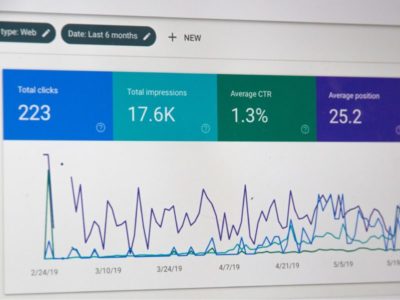A website that fails to attract its target audience is every digital publisher’s worst nightmare. Many publishers, however, fail to understand how keyword cannibalization might be undermining their quest to attract readers.
Keyword cannibalization happens when pages from the same domain are forced to compete against one another. By spreading content that targets a single keyword across multiple pages, publishers undermine their ability to compete against websites that optimize a single page for one keyword. The end result is a waste of time, money and resources.
This problem is pronounced on bigger sites with many pages of content, but it can affect new websites too.
In this post, we’ll explore what keyword cannibalization is, why cannibalization is bad for SEO and examine best practices on how to prevent cannibalization altogether.
Let’s get started.
Table of Contents
What Is Keyword Cannibalization?
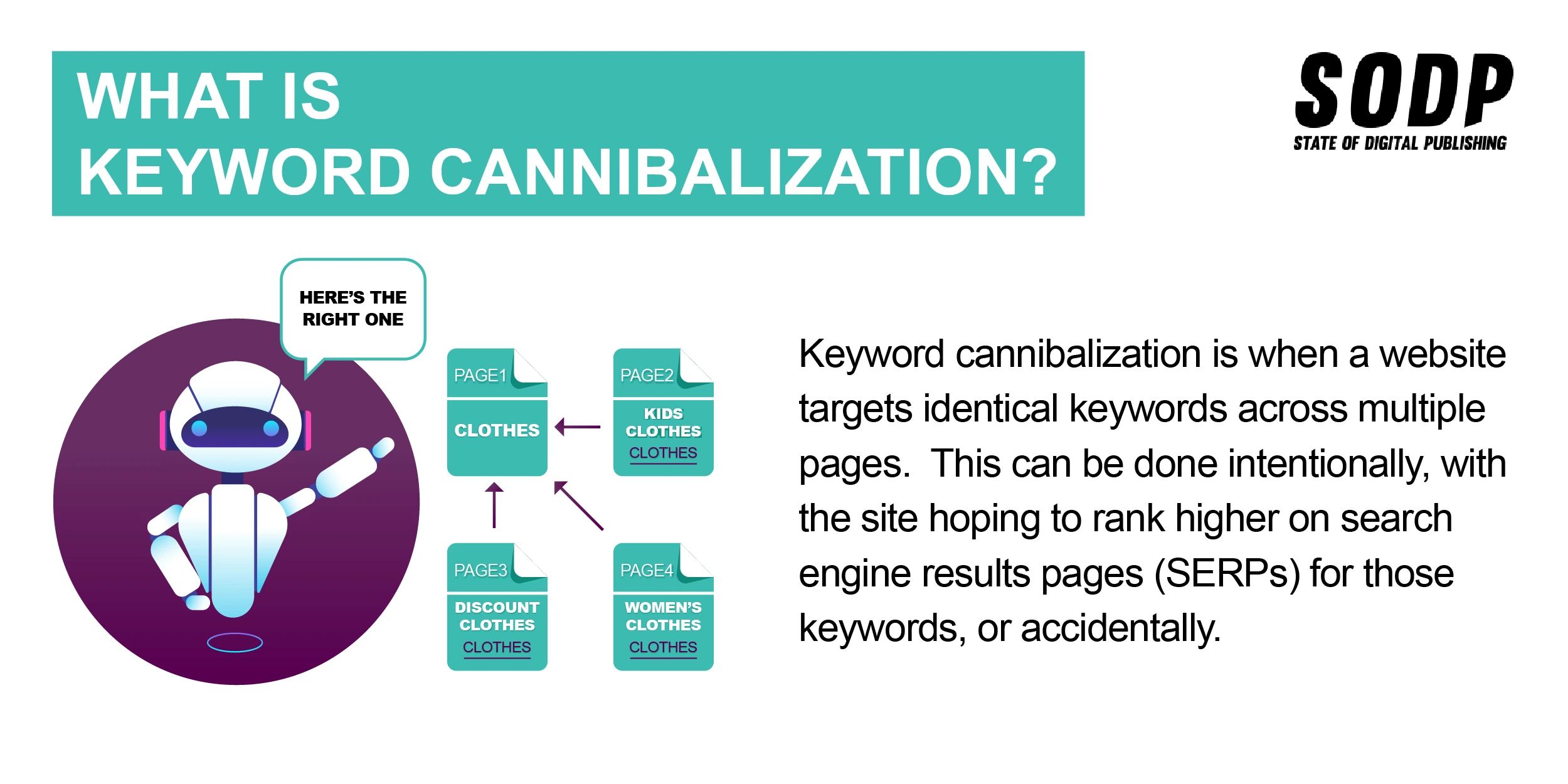
This can be done intentionally, with the site hoping to rank higher on search engine results pages (SERPs) for those keywords, or accidentally.
For example, let’s say an eCommerce store has a product page for “men’s shoes” as well as subpages that are also optimized for that keyword. If the store then creates a blog post titled “How to select the best men’s shoes”, the page will compete for the same users as the product page.
Why?
Both pages are optimized for the same keywords and intent. This can confuse Google and lead to it to rank the page that isn’t as valuable to the website.
A Few Keyword Cannibalization Examples
Keyword cannibalization can take many shapes and forms.
To better understand how keyword cannibalization issues can occur, let’s look at a few common examples.
1. Ranking Fluctuations
Websites with cannibalization issues may see their pages that rank on search engine results pages (SERPs) constantly change position.
For example, let’s say there are two pages that contain blog posts for the keyword “web design trends for marketers” — in other words, version A and version B.
While both are well-written and substantial posts, version A covers general strategies while version B provides tips relevant for 2022.
Due to their similarity, Google might rank version A initially, but later replace it with version B if it attracts more engagement and click-throughs. This fluctuation can happen repeatedly until the site resolves the cannibalization issue.
This primarily happens for two reasons. Either Google becomes confused or it receives conflicting ranking signals and updates the SERP accordingly.
Regardless of the reason, there is a risk of an irrelevant page ranking, leading to a lower click-through rate (CTR) for the desired page.
2. Great Content Struggles to Rank
Quality content that is optimized but still struggles to climb the SERPs might be suffering from keyword cannibalization issues.
For example, let’s say a website creates an in-depth 5,000 word cornerstone post on “beginner javascript tips” and receives backlinks from authority sites.
The website may expect to see the post rank on the first SERP, but it never does.
A potential reason for this could be that it is competing with another post on the same domain that targets a variation of the same keyword such as “javascript for beginners.”
What ends up happening is page authority is split between both pages. Despite one page being of higher-quality, the other drags it down and limits its ability to rank.
How Keyword Cannibalization Affects SEO
Regardless of the reason for keyword cannibalization, it makes websites less efficient and forces them to self-compete for relevant keywords.
This, in turn, dilutes organic performance of pages on SERPs and reduces effectiveness of an SEO strategy.
Let’s look at five reasons why keyword cannibalization in SEO is problematic:
1. Dilution of Page Authority
When two or more pages on a site target the same keyword, it confuses Google and splits the CTR or traffic from search engines.
Instead of one high-authority page that receives search engine traffic for a keyword, it becomes spread across several different pages, effectively lowering the likelihood for each page to rank.
2. Google May Rank the Wrong Page
Google’s algorithm follows a formula to determine how pages rank. Key to this process is understanding the content of a page through keywords.
However, if there are multiple pages with the same keyword that have similar content, Google will attempt to determine which page is the best fit by itself. This is not a foolproof system and search engines can make mistakes by assigning pages with more value a lesser ranking than pages with lower value.
3. Link Equity Takes a Hit
Keyword cannibalization negates the benefits of backlinks from other web pages.
When two or more pages compete for the same keyword, this effectively creates multiple backlink profiles, weakening the value of these external signals.
Instead of spending time and energy to acquire backlinks for multiple pages that target the same keyword, a better outcome would be to obtain backlinks for a single page to improve its performance.
Furthermore, when a single page is devoted to a keyword it allows the publisher to condense information, making a more in-depth and informative article the process. This, in turn, Increases that page’s chance of being linked to naturally.
Besides external linking issues, another keyword cannibalization issue is that there will be multiple anchor texts and internal links containing the same phrases that lead visitors to different pages, muddling the user experience.
4. Wasting Crawl Budget
Each day, search engines crawl websites to understand the content and to index them. If a page is not crawled, it won’t rank on SERPs.
A website’s crawl budget refers to the number of pages Google reviews. This value is determined by the number of pages a site has and its site health.
This can be an issue, especially for large sites. Having multiple pages with the same content and keywords means pages may end up being indexed that don’t need to be, while pages with different keywords are overlooked.
Though small sites are not really at risk of this negative effect, it still pays to follow good practice to avoid issues further down the line.
5. Conversion Rate Suffers
When keyword cannibalization occurs, it impacts the conversion rate of that keyword, or the number of visitors who take a desired action after consuming the content.
Why?
Instead of one optimized page that receives all traffic for a keyword, it becomes split across multiple pages and affects the CTR for each. Driving less traffic to each page means that visitors will land on a page not optimized for conversions.
How to Identify Keyword Cannibalization
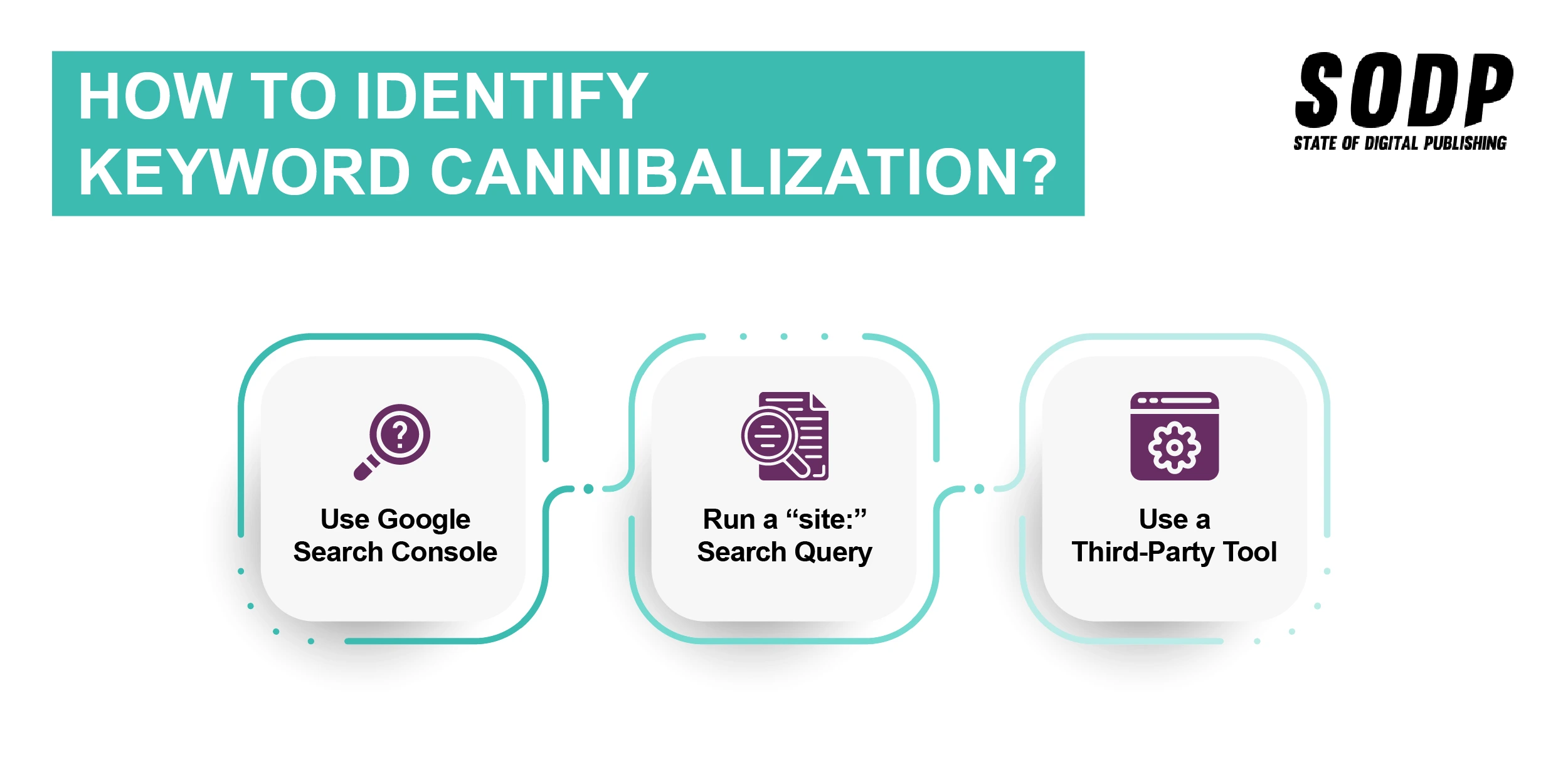
Use tools and strategies to find cannibalized keywords and duplicate pages.
1. Use Google Search Console
GSC is a free tool that allows webmasters to analyze traffic and spot a range of issues, including identifying keyword cannibalization.
To find keyword cannibalization issues on GSC, head to the Performance Report option.
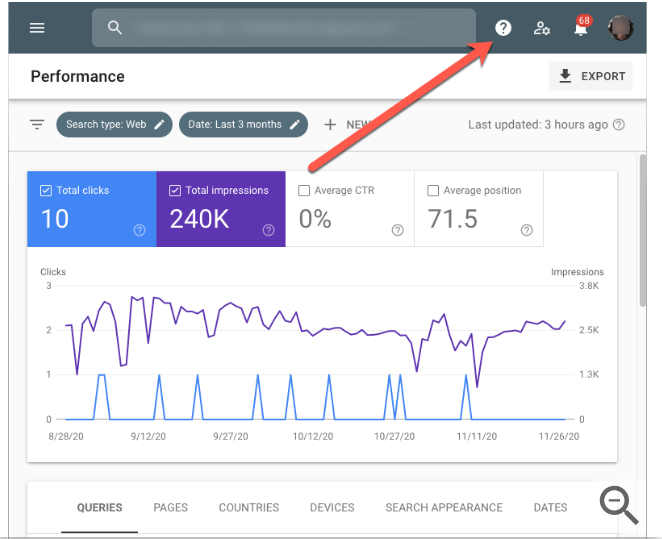
GSC should show all URLs ranking for that query and its relevant stats.
However, if GSC returns multiple URLs for a query, it’s a sign of cannibalization issues.
2. Run a “site:” Search Query
An alternative and more manual method of finding different pages on a website targeting a specific keyword is to enter a search query into Google Search.
Type the following:
site: examplesite.com keyword
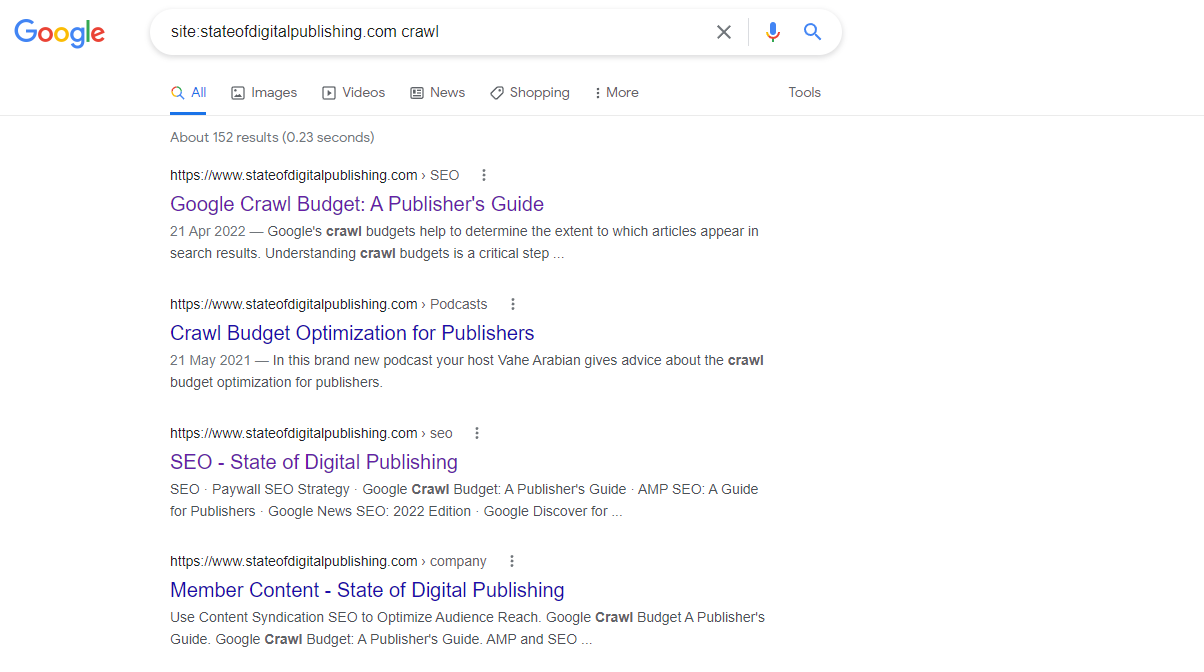
Remember, there are four types of intent: informational, transactional, navigational and commercial.
3. Use a Third-Party Tool
Companies such as Semrush offer tracking tools that their subscribers can use to identify cannibalization issues.
Semrush’s Position Tracking tool, for example, helps analyse the aforementioned URL fluctuations that can indicate cannibalization issues.
SEO Issues That Can Cause Cannibalization
Keyword cannibalization is not always the result of topic duplication.
How URLs and links on a website are structured can also cause cannibalization issues under the hood. Therefore, it’s important to be aware of both common and uncommon SEO issues that impede content performance on SERPs.
Often, the URL structure of pages can lead to cannibalization.
Common Problems
1. Numbers in URL
Listicles or numbered-format content often feature the number of items in the article in the URL. Generally, this is considered bad practice as it complicates future updates.
While using a number in a listicle may seem harmless, a future update means the URL will no longer match the post. To avoid this, some websites may create a new version of the listicle entirely.
In doing so, they may forget to redirect the older version to the new post.
The result? Two very similar listicles with different URLs, which is a prime ingredient for cannibalization.
For example, eCommerce stores, which often use the listicle format to help users make a purchase decision, may create a post like this:
- https://www.example.com/10-best-hiking-shoes
However, six months later, as brands release new products, the store may decide to update the post to include 15 recommendations. However, updating the URL to reflect that change will not be possible.
- https://www.example.com/15-best-hiking-shoes
Thus, the general rule of thumb is to omit numbers in URLs to make future updates easy.
2. Keyword Variation in URL
Another common source of keyword cannibalization is publishers using variations of a keyword in the URL of pages targeting the same or similar topic.
While the publisher may believe these topics and keywords are different, Google may view both variations as the same when serving search results.
This is a common problem for news organizations who cover a continuously evolving topic.
For example, a news publisher covering a warzone may cover breaking news of a missile strike as follows:
- https://www.example.com/missile-strike-on-residence-accidental
But later, as new information emerges, it may run a new article with the following URL.
- https://www.example.com/missile-fire-on-residence-not-accidental
It’s possible that Google might consider both “missile strike” and “missile fire” the same when returning search results.
Therefore, websites should analyze SERPs before content creation to ensure search engines are serving different results for keyword variations. Remember, it’s always better to prevent the problem than to search for a band-aid later.
3. Dates in the URL
To give users the best experience, Google values fresh content.
Thus, content updates are a normal activity in SEO. However, when publishers include a date or year in the URL, updates become problematic.
Again, instead of being able to easily update an old post and benefit from its existing ranking, publishers will likely have to create a new post to ensure the URL matches the year of the update.
Uncommon Problems
4. Site Structure Concerns
Google values how internal links are distributed on a website, as they help Google find more content and better serve users. A standard rule in SEO is that all pages should be no more than three clicks away.
As such, keep a close eye on site structure, especially during a site redesign or changes in appearance of each page as a shift to a clean design can negatively impact rankings.
Often, the clutter of a page such as sidebars linking to related content or content recommendations naturally increase internal links.
Thus, always strive for a conventional flat structure for optimal performance.
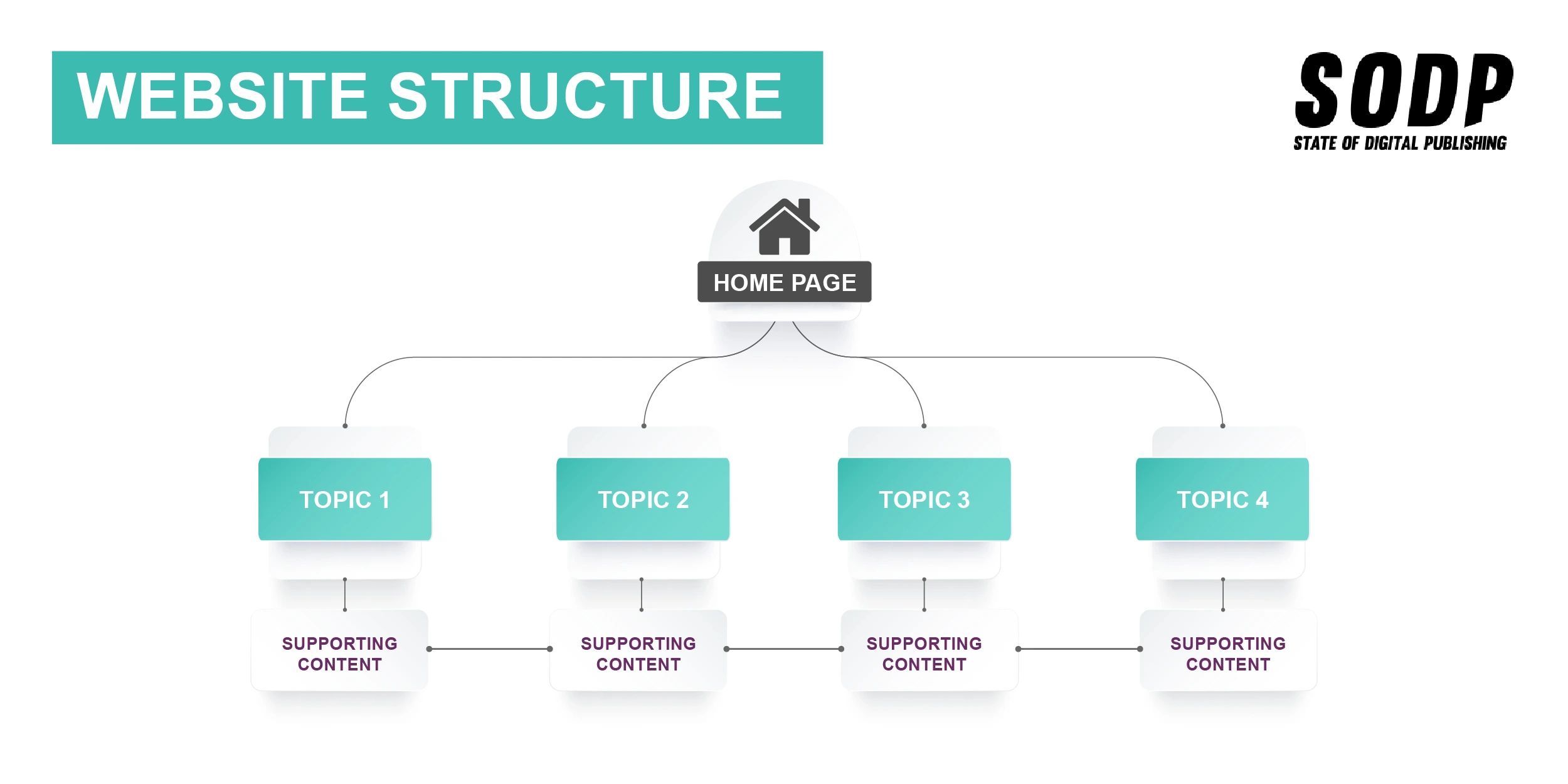
Other internal links nuances to be mindful include:
- Use an exact match anchor text for internal hyperlinks
- Maintain a healthy balance of internal links on each page
How to Apply Fixes
Without a clear understanding of how keyword cannibalization affects a website, figuring out the correct course of action is an uphill task.
Blindly applying a fix presents a greater risk of doing more harm to website performance.
Therefore, a strategic checklist that guides a website’s response to cannibalization is an important tool every publisher should incorporate into their workflow.
Resolving cannibalization correctly the first time requires precision and thus, having awareness of each possible scenario and the apt response for it is important.
This helps websites save time, money and resources, but more importantly, it establishes a culture of checks and balances to ensure performance and the bottom line is not affected.
Let’s say a content audit reveals cannibalization with two posts targeting the same keyword.
A website should ask each of the questions below to guide their response:
1. Can the topic be approached from another angle and still appeal to the audience?
If the answer is yes, focus on reworking one of the pieces. This is a great time to explore similar keywords that will still engage readers but are different enough to resolve cannibalization.
But if there are absolutely no alternatives possible, it’s better to remove one of the posts and explore another keyword entirely.
2. Does it make sense to combine content of both posts into one new piece?
Let’s look back to our earlier example of an eCommerce store cannibalizing itself by creating two separate listicles to recommend hiking shoes.
In that scenario, the use of numbers in the URL forced the store to create two posts, but could the situation have been avoided by merging content?
With a little strategy, certainly.
For example, the store could have added multiple recommendations under one subheading by categorizing shoes according to the brand, use case, or any other shared common feature.
Thus, the ability to curate, and merge information into a single, longer authoritative post for better performance is a powerful way to fix cannibalization with little effort.
3. Can cannibalized content be converted into a different format?
From video content to infographics, content is disseminated in various ways.
Cannibalization is a good opportunity to review if information could be shared another way.
Let’s say a website has a series of posts sharing the results of a study on an A/B test of page titles. Rather than create a series of posts using the same keyword, a single detailed infographic could draw more clicks and eliminate cannibalization at the same time.
4. Is the content complete? Can more information be added to make posts relevant and useful?
This step will require a website to investigate its depth of coverage of a keyword. A quick glance at the top ranking posts can reveal what Google is looking for.
Does it feature extra information? If so, pick the better performing variant and add additional content to make it as useful to readers as possible.
5. Is the content outdated?
Often, content that is no longer fresh or relevant could be cannibalizing newer posts.
In this case, a consolidation and update is the best course of action. To do this, a website should be aware of the latest trends and breakthroughs in its niche.
With an understanding of what steps to take in various scenarios, let’s now look in detail how to resolve keyword cannibalization.
How to Fix Keyword Cannibalization
Once a website has definitive proof of keyword cannibalization, it’s time to apply a fix.
Fortunately, there are many ways to address the issue. The following section explores the strategies a website can employ to reverse the damage caused by keyword cannibalization and provide guidance on how to avoid making the same mistakes in the future.
Here are eight common solutions:
1. Focus on Keyword Clusters
Keyword clusters refers to a grouping of keywords that are similar. Generally, such clusters are built laterally from a “main” keyword. The focus of similar keywords is on long-tail alternatives.
Long-tail keywords are longer (three to five words), and more specific keyword phrases that searchers type when they are close to the point of purchase.
For example, let’s say a website is ranking for the keyword “marketing”. Instead of writing another article focusing on that keyword, target a long-tail variation such as “marketing tips for nonprofits” or “marketing for a new startup”.
To find long-tail keyword alternatives or a cluster of related keywords, use a tool like SurferSEO to speed up the process.
Another option is Google. For example, Google Search’s autocomplete function is a great way to uncover long-tail ideas by typing the main keyword and waiting for Google to show popular alternatives.
However, make sure long-tail alternatives fit the vision of the website.
A client of Keyword Insights’ keyword clustering tool was able to identify cannibalizing content and remove it from the website. This led to a 110% increase in traffic.
2. Consolidate or Merge Content
If pages competing with each other are not unique enough to warrant two pages or more, merge them into a single page.
The goal here is to create a high-authority page from multiple weaker ones. But which page should be the focus of consolidation?
First, examine each page’s analytics to determine organic traffic, bounce rate and conversion rate.
Ideally, the page with more traffic should be the one consolidated with content from other pages, especially if the latter converts better.
However, if no page clearly dominates, condense and rewrite the content as a single one page. There should be some structure and strategy to what is presented and where, which is based on learnings of traffic and conversion from previously competing pages.
3. Re-Optimize Content
Merging content is not always the right approach to addressing keyword cannibalization. For example, consider a case in which there are multiple URLs focusing on the same keyword with a healthy traffic source and backlink profile.
Which one should be merged with the other? There’s no correct answer here.
In such scenarios, one option is to reoptimize content. Keep one article focused on the target keyword and adjust the page content of the other to cover a similar keyword.
For example, let’s say two blog posts on a site rank for the keyword “SEO strategies in 2022”. One of these page’s content can be slightly modified to cover a similar keyword such as “SEO trends in 2022”.
This includes changing the page title and meta descriptions on top of the main content body.
4. Fix Internal Link Structure
Besides helping with navigation, internal links help search engines understand the relationship between pages and determine importance. Generally, a page with more internal links will have a higher rank.
Therefore, websites should review their internal link structure and make sure pages with less value for a keyword or those that they don’t want to rank are linking to a page they consider more authoritative or desirable for ranking.
This is an indirect way of telling Google which page to focus on when there are many pages focusing on the same keywords.
A similar approach should be taken for inbound links or backlinks to your site.
External links are also ranking factors and if another website, especially one with high domain authority, links to a less relevant page, it can lead to multiple pages from the same website to rank.
To avoid this, contact the webmaster of the site linking to an undesirable page to update the link. Ideally, they should replace the less desirable link to a new one on the same website, but this may not always happen.
5. Use 301 Redirects
A 301 redirect in SEO is a permanent redirect from one URL to another.
Once in place, users who attempt to visit a page that’s been redirected will automatically be taken to another URL the website wants them to see.
A 301 redirect allows cannibalizing pages to be taken offline and pass on the ranking signal of the old page to the new one.
To help determine which is the best page to re-link to from a number of pages cannibalizing each other, consider traffic over time and the number of organic links pointing to each page.
After implementing redirects, be sure to update the internal linking structure to ensure there are no links to removed pages. Once a 301 redirect is in place, the page will quickly drop out of Google’s index.
6. Restructure the Website
When there is an excess of multiple pages targeting the same keywords, relying on 301 redirects can be problematic. While a single redirect request will not slow PageSpeed, redirect chains can cause problems and should be avoided.
Content from our partners
In such cases, an easy way to fix keyword cannibalization is to turn the most authoritative page of a keyword into a landing page.
This page will act as the central hub and link to other subpages with similar keywords to help users move between pages with more in-depth content and the main page.
For example, let’s say an authority page has a targeted keyword of “men’s shoes”.
This page should then link to other similar subpages such as “men’s trekking shoes”, “men’s formal wear”, “men’s running shoes”, etc, while each of these should link back to the central page. This structuring will then send the appropriate signals to Google.
Landing pages work well especially with product pages that require organization.
7. Take Advantage of Canonicalization
Canonicalization is an SEO optimization technique to prevent search engines from ranking duplicate content.
Webmasters can use a canonical tag which is simply an HTML element to inform Google to only rank a specific URL or page for a keyword.
Following this, all link equity and other ranking signals will only be attributed to the canonical page for a specific keyword.
This is great for when a website wants to keep multiple pages for a keyword for its value, but wants only one page to rank. Canonicalization doesn’t remove pages or prevent access to them.
8. Implement Noindex
In extreme scenarios, websites can consider the noindex strategy.
Essentially, noindex is a tag that tells Google Search not to index a page and is a quick way to eliminate keyword cannibalization.
To noindex a page, websites have to add the following HTML code in the head section of each page:
<meta name=”robots” content=”noindex”/>
Unlike canonicalization, this option removes any chance of a page ranking on SERPs as it is de-indexed. So, use this option carefully as this will be hard to reverse if circumstances change in the future.
Generally, this option is preferred for pages with thin content with no backlinks or traffic. Examples of these types of pages include tag pages on a blog.
Best Practices to Avoid Keyword Cannibalization
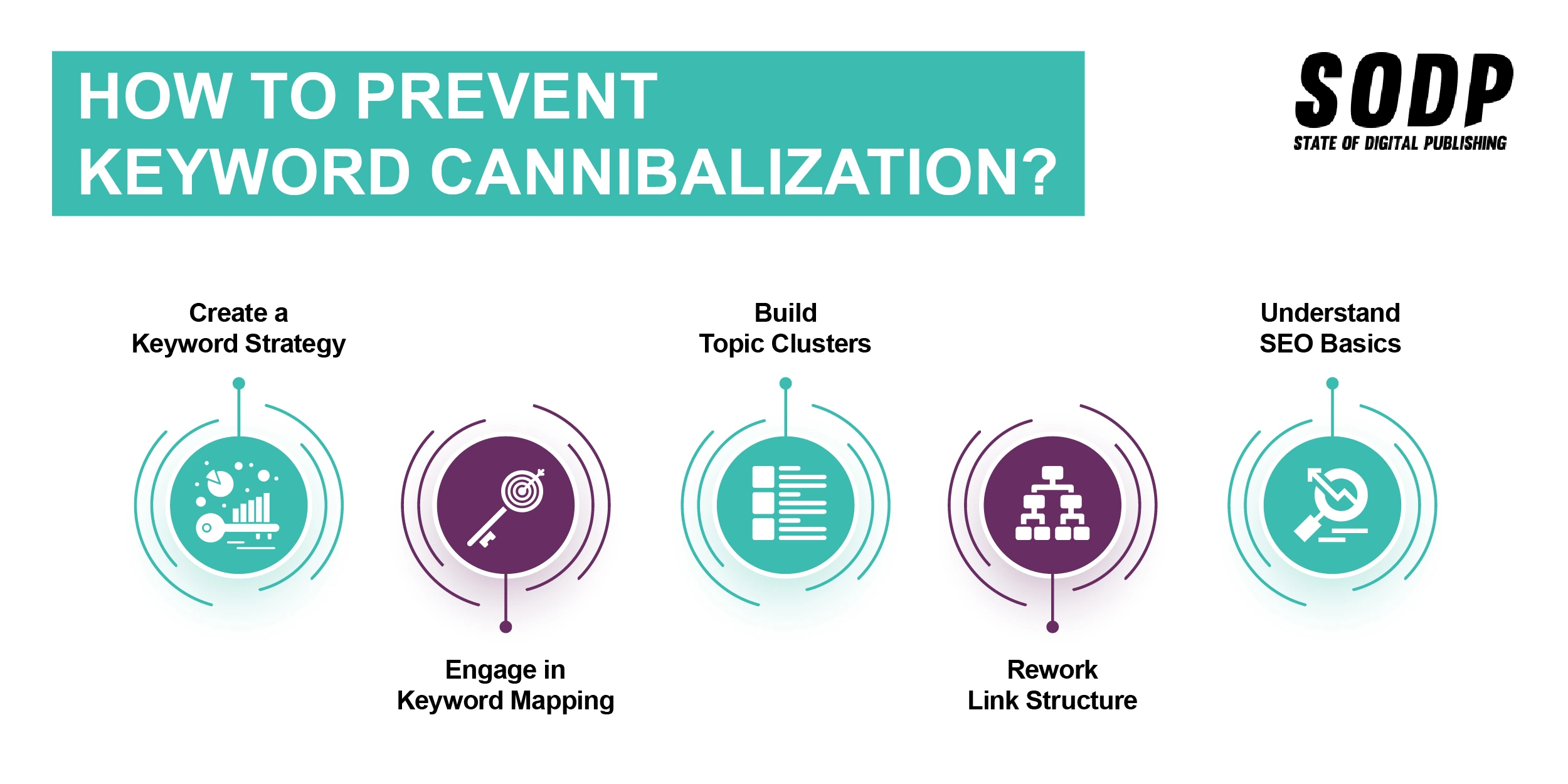
We’ve created a list of best practices that publishers can use to do just that.
1. Create a Keyword Strategy
One of the best ways to avoid cannibalization is through a robust keyword strategy.
This helps ensure that each page on a site targets a unique keyword or search query.
For example, a site may want to create a series of posts to educate readers on “backlink tactics”. However, rather than write three posts focusing on the same keyword, it might target similar keywords instead such as “backlink tactics for beginners” and “backlink tactics that work in 2022”.
This not only prevents cannibalization but offers more value to a diverse group of readers.
To help find new keyword ideas, check out these free keyword research tools:
2. Engage in Keyword Mapping
Besides strategy, websites should also engage in keyword mapping, which is the process of assigning keywords to a specific page.
It requires a tool such as Excel or Google Sheets to execute.
The spreadsheet should include the following about each post on the site:
- Page title
- Page type (blog post, category page, product page, etc)
- URL
- Keyword
- Secondary keywords
- Monthly traffic volume
Having a visual reference helps webmasters prevent doubling up on content that targets the same keyword and use of the same title tag, URL and subheads.
3. Build Topic Clusters
Often, keyword cannibalization issues are the result of a content strategy that is laser-focused on keywords alone.
Websites become so caught up in perfecting individual pieces of content that they forget to understand how a blog post enhances overall user experience.
Therefore, in addition to keywords, websites should focus on creating topic clusters — multiple pieces of content united by a common theme.
For example, let’s say a marketing agency creates a landing page on “on-page SEO” as a content pillar. It can then use this as a base to target related keywords such as “optimizing images for SEO”.
Not only does this help the site provide comprehensive coverage and build its reputation as a subject-matter expert, but it serves user interest and targets unique keywords.
A great way to find what users are actually interested in is to go where they hang out. Instead of a keyword tool, browse niche forums on platforms such as Reddit or Quora where it’s easy to see the exact language people use.
Other ways to find ideas for cluster content is to conduct surveys, run social media polls or engage in activities where direct interaction is possible.
4. Rework Link Structure
Internal links point from one page to another on the same website. When internal links with the same anchor text lead visitors to different pages, Google will automatically determine which version is best for that query.
But Google isn’t perfect.
It can prioritize a cannibalized page. Subsequently, this will influence SERP rankings and can cause a page with a higher conversion rate to take a hit.
Therefore, routine examination of a site’s internal link structure is recommended to eliminate potential cannibalization issues.
Hyperlinks with the same exact match anchor text should lead to one page. In case they don’t, update the links and make sure they point to the page to be ranked.
5. Understand SEO Basics
Keyword cannibalization often occurs because of a lack of SEO understanding.
Technical SEO issues such as bad site architecture and use of similar meta tags can confuse Google’s crawler and lead to cannibalization issues.
Moreover, redundancies such as two articles that target a similar keyword and have sections that overlap can lead Google to believe there is duplicate content. Being able to spot such issues and make changes as needed is important to prevent and reverse the effects of cannibalization.
Last but not least, making all pages consistent in style and format is also a critical SEO factor to avoid cannibalization.
Final Thoughts
Keyword cannibalization may sound scary, but it’s a mistake websites must learn to fix and prevent.
Time and resources spent on marketing efforts can be ruined in a few seconds as cannibalization impacts user experience which in turn negatively affects SEO and website performance.
Fortunately, websites can reverse the effects of keyword cannibalization and prevent it from happening by following good practices such as planning content, creating a smart keyword strategy and understanding content from the perspective of both users and search engines.


